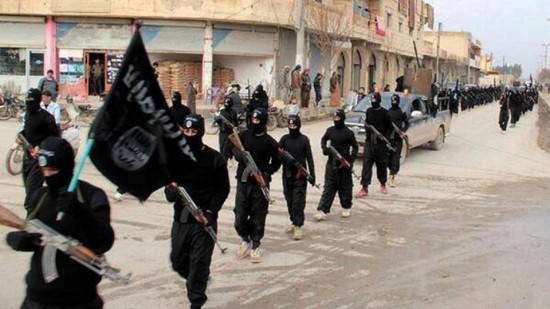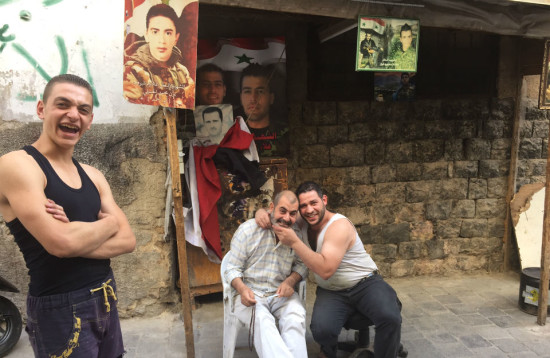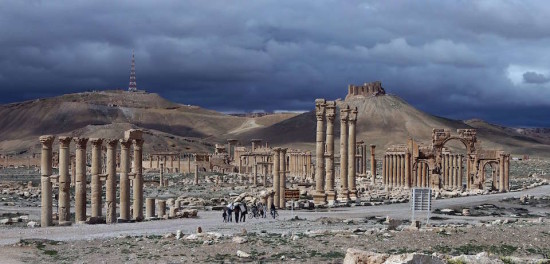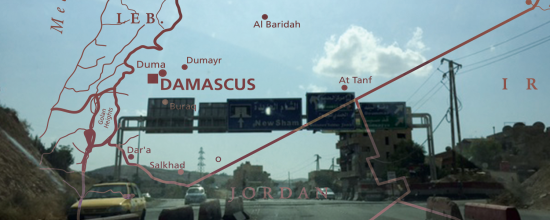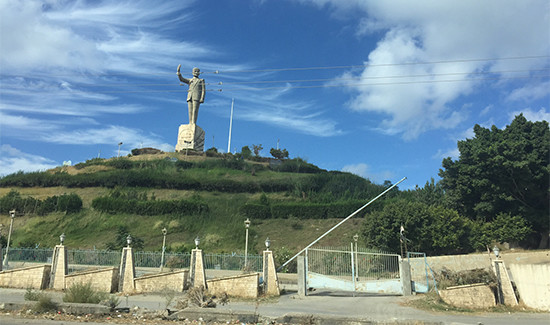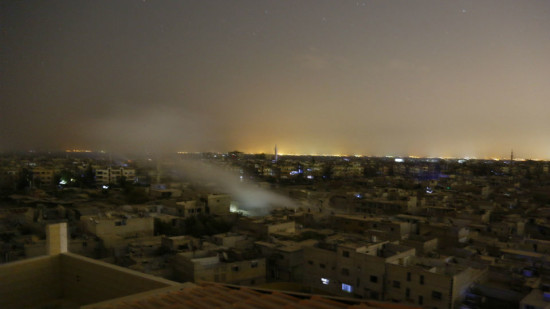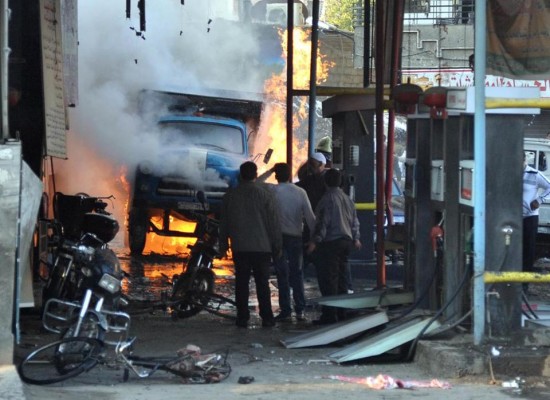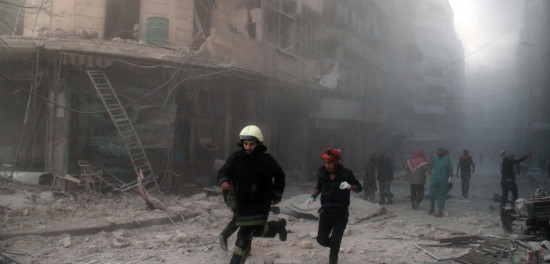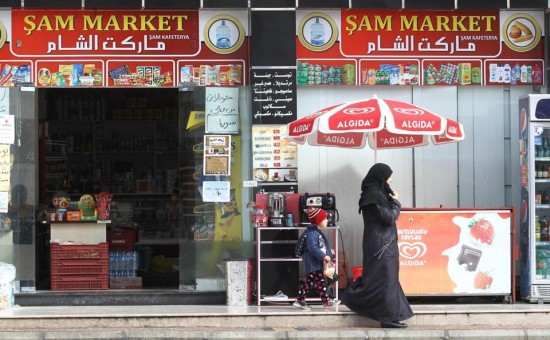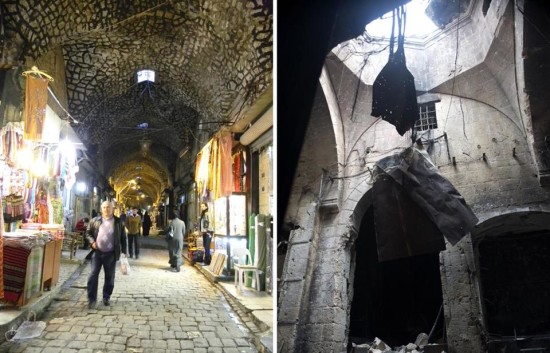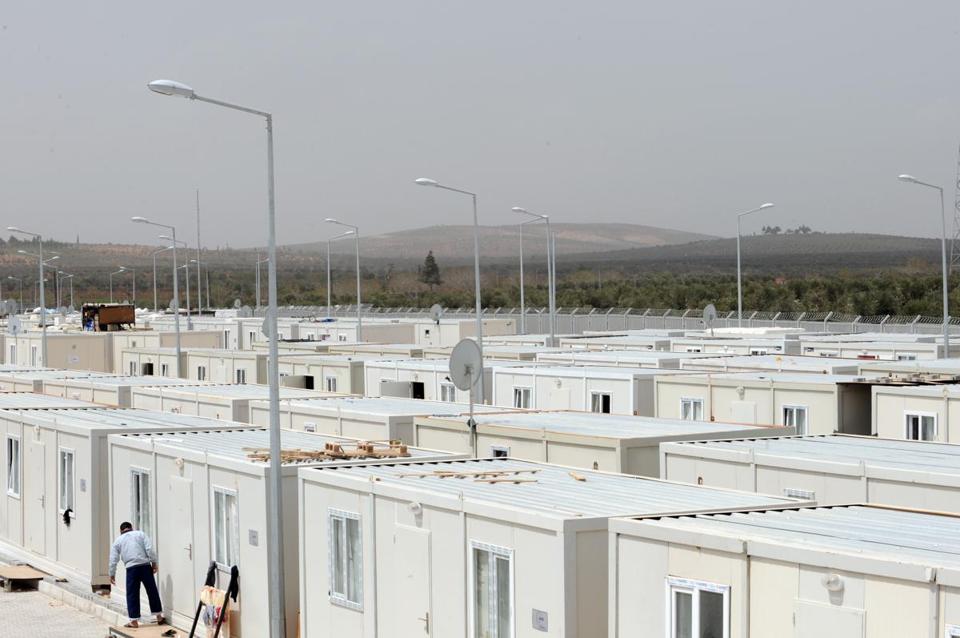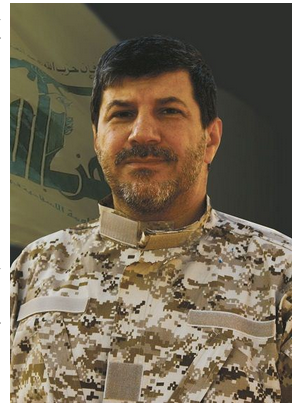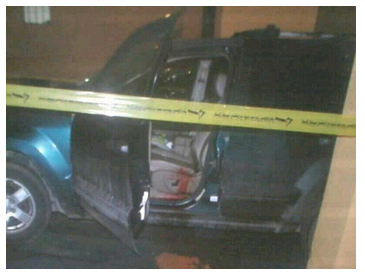
Issue brief for The Century Foundation. Download as pdf.
With the Iran nuclear negotiations concluded, attention ought to shift to a political solution for the troubling war in Syria, which has killed about a quarter-million people (estimates range from 230,000 to 320,0001), while displacing 4 million refugees into the Levant and Turkey.2
The United States remains an indispensable source of influence in the Middle East—when it chooses to get involved. It can shift the dynamics of the Syrian civil war by taking two steps. First, Washington should pour a new, higher level of support into the northern front of the civil war, in coordination with key allies, including Turkey and Saudi Arabia. Second, it should continue to promote an end to the war through political negotiations that include all the key domestic and international actors in the conflict and exclude only the most extreme jihadist rebels.
A sustained intervention through proxies on Syria’s northern front would be a messy and inconclusive affair, but if carefully tailored, with pragmatic expectations, it could completely shift the political horizon for the Syrian civil war. No foreign intervention can create an idealistic group of democratic, secular rebels ready to take over the entire country of Syria and replace the regime. With international support, however, it is possible to create a coalition of nationalist rebels capable of making gains against both the regime in Damascus and jihadist extremists, including ISIS, the Nusra Front, and Ahrar al-Sham. An invigorated nationalist opposition could provide the final incentive needed to bring Syria’s combatants into a productive negotiating process.
The conflict is newly ripe for a diplomatic resolution, requiring only a catalyst. Russia, focused on the Ukraine crisis, would entertain an end to the war that preserved its status quo security interests in the Levant. The political and economic windfall from the nuclear deal in Vienna could prompt Iran to increase its aggressive involvement in Syria,3 but it might simultaneously make Iran more open to discussions of a settlement.4 An insecure and aggrieved Saudi Arabia will need to be wooed, as its leaders are irritated by the prospect of a U.S.-Iran rapprochement.5 Yet, the rise of entrenched jihadis and the civilian bloodletting in Syria is equally troubling for the Saudis.6 Turkey is increasingly facing the risk of a spillover effect from the conflict in Syria, and would benefit from a calming of the crisis along its borders.7
All these factors suggest that a well-designed U.S. initiative, coupled with a concerted push to shift the military balance of power on the northern front, could trigger a genuine effort to negotiate an end to the war in Syria.
Existing Intervention: A Sorry Mess
Currently, the Damascus regime and its Iranian backers have encountered little resistance to their maximalist, often criminal tactics. The regime appears to continue to use chemical weapons with little consequence.8 Its armed forces and semiofficial militias have massacred tens of thousands of civilians by dropping barrel bombs, naval mines, and other indiscriminate explosives on neighborhoods under rebel control.9 Yet, the international community has raised no meaningful objections.
American involvement in Syria has been desultory. More than a year ago, when the Islamic State of Iraq and al-Shām (ISIS) expanded its dominion in Syria and Iraq and captured the city of Mosul, Washington vowed to do something; it would no longer consider the war in Syria a strategically inconsequential problem that could be ignored. But a year later, the United States has lagged on its promise to train and equip Syrian rebels. The latest venture, approved a year ago with a $500 million budget, just sent its first class of recruits into the field in July—a paltry contingent of sixty.10 The Pentagon is hamstrung by its obsession with vetting fighters, and its standards are so impractical and unrealistic that they disqualify most credible commanders. The train-and-equip program is further hampered by the insistence that its graduates only fight Islamist jihadists rather than the regime in Damascus.
The U.S. Department of Defense (DOD) has not even decided what kind of support to give to the soldiers it has dispatched into northern Syria under the latest iteration of train-and-equip. “I think we have some obligations to them once they are inserted in the field,” Secretary of Defense Ashton Carter told a congressional committee. “They know that we will provide support to them.” But he could not specify what that support would entail: “We have not told them yet,” Carter said the week the newly trained fighters were deployed.11
The U.S. air campaign against ISIS has struck limited targets. With few trusted local proxies on the ground, the U.S. Air Force can have only minimal impact. For now, the only local proxy with fighters on the ground that can regularly ask for U.S. air strikes is the Kurdish People’s Protection Units (YPG).12 The YPG has successfully taken some territory from ISIS, but is anathema to Turkey. Whenever the YPG is too successful, as in June when it captured the border crossing of Tal Abyad between Turkey and Syria,13 the Turks become alarmed and resentful. Ankara considers the YPG as indistinguishable from the PKK, militant Kurdish separatists who have waged an on-again off-again violent campaign in Turkey. The Turkish government will never support an anti-ISIS or anti-Assad campaign dominated by the YPG Kurds.
Meanwhile, as U.S. efforts have floundered, ISIS continues to deepen its state structures, military capacity, and territorial control, and it looks more like an established entity with each passing day.14
With all this bad news and so many unreliable partners on the ground, it’s no wonder that President Obama has kept his distance. Rebels willing to do business with the CIA, DOD and other government agencies have proven a mixed bag. In 2014, for instance, the United States invested considerable resources in Jamal Maarouf’s secular nationalist Syria Revolutionaries’ Front (SRF), which then took control of much of Idlib province. U.S. involvement initially was viewed as a success; a modest amount of money, along with anti-tank missiles, had shifted the battle in favor of “moderate” rebels. In practice, the rebels proved not so moderate, and the success was short lived. The SRF’s governance of Idlib was capricious and riddled with corruption. Civilians in Idlib came to resent the inconsistency and predatory abuses of their liberators. The province suffered punishing regime air strikes, as do all areas liberated by rebels. Eventually, Islamists took over the province and roundly defeated the SRF, which then collapsed.15
Today, the liberated areas of Idlib province are controlled mostly by the Nusra Front (Syria’s Al Qaeda affiliate), and Ahrar el-Sham, a jihadi group that has won plaudits for being more homegrown and nationalist than ISIS and Nusra, but which in practice shares their extreme views, which are incompatible with a pluralistic or secular state. The areas of Idlib province controlled by secular nationalists under the banner of the Free Syrian Army (FSA) survive as timid oases of relative moderation. FSA commanders interviewed in Reyhanli said they do not even try to control local governance, the economy, or social services (as Islamist militias do in their domains), and they admit that they must surrender some share of their resources and weapons to the Islamists who control the FSA’s access to Idlib. They rely on the black market for fuel, sometimes indirectly buying the diesel for their tanks and vehicles from ISIS.
Willing Partners
The good news is that there are still plenty of commanders willing to fight under the banner of the FSA, do business with the United States, and espouse political principles and talking points that make them palatable to mainstream Syrians. A recent visit to the Turkish-Syrian border showed a growing group of commanders who control boots on the ground, have a nationalist, rather than Islamist style, and have demonstrated an ability to learn politically.
“At the end we will support any government that gives all Syrians their rights,” Colonel Fares Bayyoush, an army defector who commands an FSA brigade in Idlib province, said in an interview at his headquarters in the Turkish border town of Reyhanli. “From our side, we are going to behave like Syrians. . .If we in the FSA get power, we will protect coexistence.” Half a dozen FSA commanders interviewed in Reyhanli and Gaziantep voiced the same refrain: they want a resolution to the Syrian war that protects all sects and ethnicities, and they want to eliminate the jihadist groups while reintegrating their supporters into society. They have demonstrated a history of coordinating military operations with Kurds and with Islamist fighters. They express a willingness to negotiate with elements of the regime, and they claim to include Christians, Druze and Alawites among the ranks of their fighters.
Much of this sentiment is probably tailored for Western consumption, but it also marks a considerable shift compared to a year ago. Interviews in the same border towns with the same groups in the summer of 2014 had revealed a propensity for grandstanding, Sunni triumphalism, and petulant demands that the U.S. military intervene directly and win the war for the opposition. Today, the same commanders have learned a new political language. The rhetoric of rights and national unity in the hands of pragmatic fighters signals the beginnings of a national accord that could lead Syria out of its fratricidal war.
So long as the United States is looking for a functional alliance and not for idealized founding fathers, it can find what it needs to shift the Syrian dynamic among the grab-bag of Syrian nationalists clamoring for American money and weapons on the northern front.
The framework for forming this alliance already exists. The United States, Turkey, Saudi Arabia, and other aligned players dispense military aid and cash to their preferred rebels through coordinating bodies—known colloquially among fighters as “military operations rooms”—in Reyhanli, Turkey and Aleppo, Syria. Some powers are believed also to fund favored proxies independently on the sly, but the operations rooms were founded with the stated goal of streamlining and unifying the funding of anti-Assad rebels.
And there is evidence to support this approach. Whenever the major outside powers work together to direct their weapons, funding, and intelligence in tandem, there are considerable gains on the ground as witnessed in the regime losses in Idlib and Aleppo provinces over the last year.16 When foreign powers work at loggerheads, fractiousness increases, along with infighting within and between the nationalist FSA, the Islamists, the Kurds, and the regime.
Changing the Dynamic on the Ground
The groups seeking aid through the operations rooms have proven their elasticity. Some, like the Noureddin Zinki Brigades, temporarily lost American backing when some of their weapons ended up in the hands of jihadists.17 Much of this leakage is unavoidable. For example, in Idlib province, the secular nationalist FSA brigades desperate to keep American support still operate at the pleasure of the militarily dominant Islamists.
This is a dynamic that the United States can change. First, it must make some tough choices in tandem with key allies: Turkey, Saudi Arabia, Qatar, and perhaps other regional players such as Jordan and the United Arab Emirates. There are at least a dozen rebel groups well known to foreign governments. The foreign backers of the anti-Assad forces must agree on a small number of commanders and groups acceptable to all
Perfection will be the enemy of progress. None of the FSA militias are ideal, but most of them have nationalist roots and agree on the key points that inform long-term U.S. goals: preservation of Syria’s borders, a pluralistic state that safeguards the rights of all ethnic and sectarian communities, and an end to foreign domination of the state. Saudi Arabia will dislike Muslim Brotherhood militias. Turkey will prefer groups with a Sunni Islamic flavor and will seek to minimize the role of the Kurdish YPG militias. The United States will want a commander who pays lip service to America’s political vision for Syria. These lowest-common denominator characteristics can be found in a single militia.
The nationalist groups whose long term goal is to hold power in Syria also have come to understand that it’s not feasible to massacre members of minority groups, dictate terms to foreign powers, or transform Syria into an Islamic republic. A year ago, many FSA commanders interviewed in the border region were not willing to openly espouse nationalist political goal, or did not understand the type of political language that would enable them to win international support. Today, many of them have learned an entirely new vocabulary. FSA battalions have united in a coherent communications structure, which is ripe for sustained international backing.
An effective strategy would have to follow a long-term plan that includes, at a minimum, the following elements:
1. Coordinated backing of a single commander, or small number of commanders. The United States, Turkey, Qatar, and Saudi Arabia would have to direct their resources in harmony to selected groups and exclude funding and weapons for all others. As has occurred throughout the Syrian conflict whenever funding shifted, fighters would abandon atrophying brigades and join the well-funded and well-armed groups.
2. Effective governance of rebel areas. The foreign backers, led by the United States, would have to keep their proxies on a short leash, forcing rather than trusting them to behave well. That means long-term funding and arming that is dispensed in weekly bursts and carefully monitored. If a proxy group mistreats minorities, or engages in black market fuel trade, or extorts money from civilians, it will forfeit its weekly cash payment. The United States and others will also have to send huge amounts of nonmilitary aid to enable effective governance in liberated areas, which would require a full buy-in from Turkey.
3. Security in liberated areas. Unless liberated areas are safe for civilians, the regime will win even when it loses. There are many options, but all of them require an end to the Damascus regime’s unfettered control of Syria’s airspace. Curtailing the Syrian regime’s sovereignty would entail a significant change in U.S. commitment, which will require a change of position by the White House and political legwork domestically to win approval. The most maximal option is a no-fly zone supported by the United States and Turkey. In a less dramatic move, the United States could back a no-fly zone enforced by Turkey and the United Arab Emirates. It could politically support a middle option whereby Turkey would shoot down regime bombers and helicopters using land-based systems in Turkey. Or, at the most minimal, international teams of special forces (from Jordan, the United Arab Emirates, Turkey or the United States) could sporadically shoot down regime bombers using portable surface-to-air missiles. This last option would introduce enough risk and uncertainty for the regime that it would be forced to reduce its indiscriminate bombing. One reasonable objection is that most liberated areas are currently controlled by Islamist extremists: Ahrar al-Sham, Nusra, and ISIS. The United States understandably does not want to be seen acting as Al Qaeda’s air force, which is why it’s crucial that air cover evolves in tandem with backing for nationalist, non-jihadi rebels. Air cover and an internationally backed safe zone should be extended as a start over any area held by non-jihadi rebels.
4. Shifting the political and military balance of power. Gains by nationalist rebels would weaken the Islamists (ISIS, Nusra, and Ahrar) and would also weaken the regime. It is crucial that nationalist rebels, backed by the United States and others, win support and trust from fence-sitters, tribes, and rural religious Sunni Arabs who currently tilt toward Islamist groups or the regime. The U.S.-backed rebels would have to avoid sectarian massacres or Sunni triumphalism. They would have to continue showing an ability to work with all Syrian sects and ethnicities and continue espousing a commitment to a secular nationalist governing ideology that preserves Syria’s territorial integrity and opposes Islamist extremists. Such a position would make the rebels palatable to mainstream Syrians as well as to political actors with whom the opposition will ultimately have to reconcile in a negotiated settlement: quiescent members of the business class from every ethnic and sectarian background, the ruling elite, and its international backers.
5. A peace process. U.S.-orchestrated intervention on Syria’s northern front can feed a process of negotiating a political settlement. Rebels cannot win outright; neither can the regime or the Islamists. But a consolidated front of nationalist rebels can make peace with a subset of the regime and begin the arduous process of reconstituting the Syrian state. For a new strategy to succeed, the United States would have to regularly renew its invitation and commitment to support an inclusive political negotiating process to end the war.
A Long Haul
The United States has been mysteriously AWOL in Syria, even since “declaring war on ISIS” a year ago and undertaking a desultory bombing campaign. Now, with the peril of Iran’s nuclear program apparently contained, the United States ought to ramp up its diplomatic and indirect military engagement in Syria, with the intention of forcing a fair political settlement.
A concerted and sustained U.S.-orchestrated campaign to empower one faction of nationalist rebels could do wonders to change the dynamics of the fitful negotiations to resolve the Syrian civil war. There’s nothing the United States could do to make the anti-Assad rebels win, even if it wanted to. But by placing its thumb on the scale with a vigor that it has so far avoided, the United States could propel its preferred faction to dominance within the fractured milieu of anti-Assad forces.
The United States could alter the dynamic of the war and the position of key outside sponsors of the conflict—Turkey, Saudi Arabia, and Qatar—with a sustained political and military commitment to nationalist rebels who express a commitment to a multi-ethnic and multi-sectarian Syria within its current borders and based on an inclusive definition of citizenship.
Such a partnership is feasible, so long as it has realistic aims: not to win the war for one faction or hope to eliminate jihadist extremists overnight, but to make all parties to the civil war realize that a political compromise will leave them better off than a continued war.
The mechanics are clear. First, the United States must acknowledge that a resolution in Syria will require the involvement of all the parties to the conflict, including Washington’s unsavory allies and its persistent rivals. Iran, Russia, Saudi Arabia, Qatar, and Turkey will have to be at the negotiating table. So will some unseemly Islamist rebel factions. Any party excluded from negotiations, like ISIS or the Al Qaeda-affiliated Nusra Front, must be instead roundly defeated with military force. It is not possible to ignore the extremist groups and yet concede them the territory under their control.
Any new approach could still take years to change the overall direction of Syria’s war. A shift in the U.S. approach to the northern front would require considerable diplomatic work with Turkey and Arab allies. But a pragmatic plan could get the key players onside and frame the goals for the conflict in a more realistic way. Nothing will change as long as each group of combatants thinks it can achieve total victory. But the political dynamics will change as the balance of power on the ground shifts, and the only proven force that has affected the course of the conflict to date has been the sustained flow of money, weapons, and foreign political attention.
At worst, the United States will fail to persuade all its allies to fully cooperate with the strategy and will end up with a few tighter partnerships among the rebels, but no major strategic yield. At best, the United States will convince the other sponsors of the Syrian conflict that they no longer have free access to run killing fields and that they will have to pay a much higher price to stick with the status quo—or else will have to look for political compromises.
Notes
1 Estimates from the United Nations and Western news agencies place the minimum death toll at 230,000. The Syrian Observatory for Human Rights estimates a minimum death toll of 320,000.
2 In addition to the 4 million refugees who have fled Syria, nearly 8 million internally displaced people have been forced from their homes but still live in the country. See Nick Cummings-Bruce, “Number of Syrian Refugees Climbs to More Than 4 Million,” New York Times, July 9, 2015,http://www.nytimes.com/2015/07/09/world/middleeast/number-of-syrian-refugees-climbs-to-more-than-4-million.html?_r=0.
3 Sean D. Naylor, “Will Curbing Iran’s Nuclear Threat Boost Its Proxies?” Foreign Policy, July 20, 2015, http://foreignpolicy.com/2015/07/20/will-curbing-irans-nuclear-threat-boost-its-proxies/.
4 Jessica Schulberg, “Obama: No End to War in Syria Without ‘Buy-In’ From Iran,” Huffington Post, July 20, 2015,http://www.huffingtonpost.com/2015/07/15/obama-iran-deal_n_7802768.html.
5 Jeremy Shapiro and Richard Sokolsky, “It’s Time to Stop Holding Saudi Arabia’s Hand,” Foreign Policy, May 12, 2015,http://foreignpolicy.com/2015/05/12/its-time-to-stop-holding-saudi-arabias-hand-gcc-summit-camp-david/.
6 David Gardner, “The Toxic Rivalry of Saudi Arabia and ISIS,” Financial Times, July 16, 2015, http://www.ft.com/intl/cms/s/0/8bba2ab4-2b00-11e5-8613-e7aedbb7bdb7.html#axzz3gdqpeelg.
7 Semih Idiz, “Turkey Needs to Drop Its Dead-End Foreign Policy,” Al-Monitor, July 21, 2015, http://www.al-monitor.com/pulse/originals/2015/07/turkey-west-european-union-us-time-to-readjust-compass.html.
8 Adam Entous, “Assad Chemical Threat Mounts,” Wall Street Journal, June 28, 2015, http://www.wsj.com/articles/assad-chemical-threat-mounts-1435535977.
9 Lucy Westcott, “United Nations: Assad’s Barrel Bombs Continue to Kill Syrian Civilians,” Newsweek, June 27, 2015,http://www.newsweek.com/united-nations-assads-barrel-bombs-continue-kill-syrian-civilians-347782.
10 Jennifer Rizzo, “Carter: U.S. Trains Only 60 Syrian Rebels,” CNN, July 7, 2015, http://www.cnn.com/2015/07/07/politics/united-states-training-syrian-rebels-ashton-carter/.
11 See Roy Gutman, “First contingent of U.S.-trained fighters enters Syria,” McClatchy, July 16, 2015, http://www.mcclatchydc.com/news/nation-world/world/article27446395.html, and Thomas Gibbons-Neff, “Syrian rebels get their first U.S.-trained fighters,” Washington Post, July 15, 2015,https://www.washingtonpost.com/world/national-security/first-us-trained-syrian-fighters-reenter-their-country/2015/07/15/6e6c0551-353d-4e17-961b-98995321576c_story.html.
12 See Denise Natali, “The Coalition’s quagmire with Syrian Kurds,” Al Monitor, July 14, 2015, http://www.al-monitor.com/pulse/originals/2015/07/coalition-quagmire-syrian-kurds.html#. See also Roy Gutman, “U.S Moves Its Syrian Air Campaign to the West,” McClatchy, June 30, 2015, http://www.mcclatchydc.com/news/nation-world/world/middle-east/article25909303.html.
13 Thomas Seibert, “ISIS is Losing in Northern Syria, but Ankara is Unhappy,” Daily Beast, June 16, 2015,http://www.thedailybeast.com/articles/2015/06/16/isis-is-losing-in-northern-syria-but-ankara-is-unhappy.html.
14Tim Arango, “ISIS Transforming Into Functioning State That Uses Terror as a Tool” New York Times, July 21, 2015,http://www.nytimes.com/2015/07/22/world/middleeast/isis-transforming-into-functioning-state-that-uses-terror-as-tool.html.
15 See Liz Sly, “U.S.-backed Syria rebels routed by fighters linked to al-Qaeda,” Washington Post, November 2, 2014,https://www.washingtonpost.com/world/us-backed-syria-rebels-routed-by-fighters-linked-to-al-qaeda/2014/11/02/7a8b1351-8fb7-4f7e-a477-66ec0a0aaf34_story.html. Zack Beauchamp, “American strategy in Syria is collapsing,” Vox, November 4, 2014,http://www.vox.com/2014/11/4/7150473/american-strategy-in-syria-is-collapsing. A similar collapse struck another U.S. favorite, the Hazm movement; see Ian Black, “US Syria policy in tatters after favoured ‘moderate’ rebels disband,” Guardian, March 2, 2015, http://www.theguardian.com/world/2015/mar/02/us-syria-policy-tatters-moderate-rebels-disband.
16 Firas abi Ali, “Syrian Opposition Success in Idlib Province Likely to Threaten Aleppo, Latakia, and Assad’s Hold on Power,” IHS Jane’s Intelligence Weekly, April 27, 2015, http://www.janes.com/article/51012/syrian-opposition-success-in-idlib-province-likely-to-threaten-aleppo-latakia-and-assad-s-hold-on-power.
17 Author interview with Noureddin Zinki Brigades official, Antakya, Turkey, June 2015.


